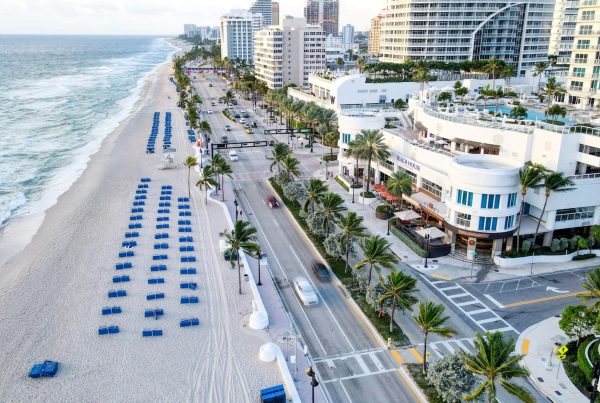After seven months, Boca Raton has approved ordinances to implement the state’s 2023 affordable housing law.
Why did it take so long?
“We were writing a new law,” Mayor Scott Singer said. “We were giving new rights” that allow residential development where the city had not allowed it.
He’s right. To fully understand the delay, however, we need to review what the Live Local Act did.
Even for a Legislature that has usurped much control over local decisions, Live Local was extraordinary. If developers propose projects that include affordable housing units and meet the conditions of the law, they do not need approval from elected officials, such as the Boca Raton City Council and Delray Beach City Commission. The staff “must authorize” the project.
I believe that Singer and council members took so much time because they didn’t want residents to have unpleasant surprises. Consider what’s happening in Bal Harbour, an affluent, oceanfront village in Miami-Dade County.
For years, the owner of a high-end shopping mall has wanted to add a hotel. City officials have refused. Last month, the owner proposed that hotel—at 20 stories—along with 600 residential units and 45,000 square feet of retail space.
Forty percent of those units would be classified as affordable and priced as such. As a mixed-use project, it qualifies under Live Local.
After residents complained, village council members passed three ordinances to stop the project. The mall owner then sued. It’s a mess. Similar messes are happening in other Florida cities and counties. Boca Raton hopes to avoid them.
One part of Live Local applies to projects with that 40 percent level of affordable housing. Boca Raton spent less time on the corresponding ordinance. “We couldn’t do that much,” Councilwoman Fran Nachlas said.
It may not matter. Projects that large require more land. Boca Raton has comparatively little left, and acquiring it is expensive. No 40 percent project has been filed in the city.
The other part of Live Local applies to projects with just 10 percent affordable housing and seems to leave local governments more discretion. Boca Raton’s ordinance prohibits these projects next to single-family neighborhoods and Palmetto Park Road east of the Intracoastal Waterway. The ordinance caps those Live Local units at 2,500 citywide.
City officials want to encourage affordable housing in northwest Boca Raton, where many businesses are located, so that employees don’t have to commute. An incentive program in areas near public transit will allow up to 15 percent affordably priced units. Developers must include at least 5,000 square feet of retail—another attempt at reducing car trips.
“I’m pleased,” said Councilman Marc Wigder, a real estate attorney. He attributed the delay to the difficulty of tailoring a statewide law to one city. Without its ordinance, Wigder said, Boca Raton would not be able to block a 150-foot building from going up next to single-family homes. This year’s follow-up bill, he said, could correct “glaring omissions.”
But Wigder does acknowledge the need for more housing that the middle class can afford. High costs have forced many employees of his Boca Raton-based company out of the city.
The city has received three applications under the 10 percent Live Local standard. One, of 295 units, would be at Boca Center near Town Center Mall. The others, for a combined 571 units, would be near the Tri-Rail station on Yamato Road and in the Park at Broken Sound. That’s where the council would like to see most Live Local projects.
“I am more happy than unhappy,” said Nachlas, who pushed for that retail requirement. She shared Wigder’s frustration that the law imposes statewide rules. “We’re a different city.”
Though council members heard plenty over the last few months from developers and their attorneys, Nachlas said almost no residents contacted her about Live Local.
Ah, but if residents get an unpleasant surprise from Live Local, Nachlas and her colleagues will hear from many of them. That is what these ordinances seek to avoid.
Bill filed to unseal Epstein grand jury testimony
Two area legislators sponsored a bill that could reveal why notorious sex trafficker Jeffrey Epstein got such a favorable deal from a former Palm Beach County state attorney and a former U.S. attorney for South Florida.
Epstein abused dozens of underage girls in his Palm Beach mansion. At one point, federal prosecutors believed that they had enough evidence to send Epstein to prison for life.
Instead, that ex-state attorney—Barry Krischer—and ex-U.S. attorney—Alexander Acosta— allowed Epstein to plead guilty in 2008 to one state charge of solicitation. He did light time in the county jail, where deputies allowed him to visit his office during the week.
That plea deal came after grand jury testimony in 2006 that until now has remained sealed, under Florida law. The bill from Sen. Tina Polsky, D-Boca Raton, and Rep. Peggy Gossett-Seidman, R-Highland Beach, would create an exception to allow disclosure of Epstein’s grand jury proceedings. After House and Senate passage, the bill awaits Gov. DeSantis’ signature.
Separately, The Palm Beach Post has sued to force disclosure, arguing that state law allows it if doing so will “further justice.” The bills also use that language. A trial court judge ruled against the paper, but an appeals court last year overruled. Despite that decision, the trial judge has not acted.
Epstein committed suicide in 2019 after being arrested on new federal charges. His death denied victims the chance to see Epstein punished and to learn why he got that sweet deal. The grand jury records may not have all those answers. But since Krischer and Acosta have refused to comment, disclosure offers the only other hope of getting to the truth.
Short-term rental bill advances to House

Speaking of Tallahassee, bills that would continue to restrict the ability of cities to regulate short-term, vacation rentals are advancing.
This topic especially matters in cities such as Boca Raton and Delray Beach, which draw lots of visitors and want to protect single-family neighborhoods from the abuses of bad landlords. In the worst cases, homes become the site of loud parties and absentee owners do nothing to stop it.
Each chamber has a different version. Both bills would allow cities to suspend rental operations—but only after five violations over an unspecified length of time. Both would set registration rules intended to make owners more accountable to the local government.
The full Senate approved SB 280 along party lines, with Republicans in favor and Democrats opposed. House Bill 1157 has cleared one committee. Because the bills are different, neither might pass. Or the House could decide to take up the Senate version.
The Florida League of Cities opposes both bills. The legislative session ends in eight days.
A new Brightline station in Stuart

Brightline has chosen Stuart for its Treasure Coast station. It’s something of an odd choice.
To settle a lawsuit by Martin and Indian River counties, the company agreed to build a station in Martin or St. Lucie County within five years of starting service from South Florida to Orlando. Service began in September. Treasure Coast governments had argued that, without a station, they would get none of the benefits from Brightline and all the hassles.
Two entities from Fort Pierce submitted bids. The city’s population is 48,000, compared to Stuart’s 18,000. Fort Pierce also is at the center of the tri-county Treasure Coast.
Another demographic, though, might have been a factor. The median household income in Martin is $78,000. In St. Lucie County, it’s $60,000. The cheapest midday, roundtrip ticket from Boca Raton to Orlando this week costs $206.
Estimated cost of the Stuart station is $60 million, with $45 million to come from the city and county. They hope to offset that with federal grants. Boca Raton paid roughly $10 million for the parking garage at the city’s station. The Stuart station could open in 2028.
Boca Raton continues to see its station as an economic asset. Singer pushed again this week for a second platform that would allow more trains to stop. The city is considering a development district centered around the station.







